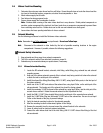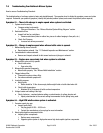
©2002 Edelbrock Corporation
Brochure No. 63-0029
Rev. 12/02
Page 23 of 26
6.0 Solenoid Inspection and Maintenance
1. Close valve on nitrous bottle.
2. Make sure all nitrous supply lines are free of pressure before removal of any system solenoid.
a. Empty main nitrous supply line at the nitrous bottle. Take care to not breathe or expose your skin to nitrous.
b. Do not open pressurized fuel lines over a hot engine.
3. Remove nitrous solenoid from the engine and securely clamp it into a vise, taking great care not to damage the solenoid.
4. Remove the solenoid cover, retaining nut from top of the nitrous solenoid.
5. Remove coil and housing from nitrous solenoid base.
6. Unscrew stem from nitrous solenoid base. Do this by using a solenoid stem removal tool or by “double nutting” the stem
and unscrewing the stem from the housing body. Do not use pliers on solenoid stem; damage to the stem will result.
7. Carefully remove the stem, spring and plunger from the solenoid base paying close attention to the way they are
assembled.
8. Examine the plunger seal for swelling, cuts and abrasions. The seal surface should be flat, except for a small circular
indentation in the center of the seal.
A seal that has been contaminated or over-pressurized will bulge from exposure to chemicals other than nitrous
oxide. It can appear to extend down from the plunger and be dome-shaped. A contaminated seal may return to its
original shape if left out in fresh air for approximately 48 hours. It may then be returned to service. If it does not return
to its original shape, it must be replaced.
9. Clean the solenoid body. Do not use an oil-based solvent to clean any part of the solenoid.
Use paint thinner
or electrical contact cleaner. Remove any contaminants that may be present. Make sure solenoid body is clean, dry
and free of oils before assembly.
10. Replace the O-Ring, plunger and piston spring.
11. Re-assemble solenoid by reversing disassembly procedure.


















